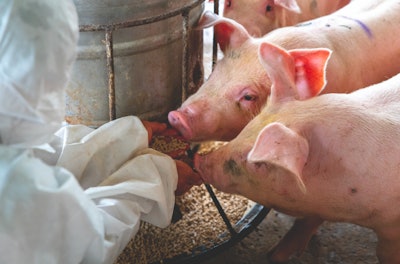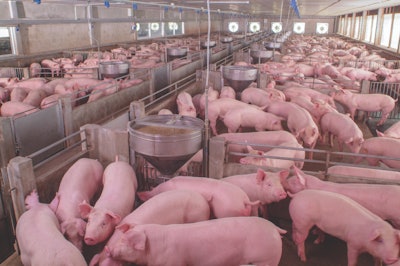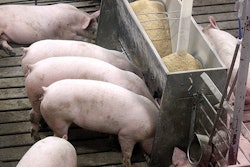
Despite challenges posed by the COVID-19 pandemic, swine and feed industries must stay diligent in fight against African swine fever.
2020 will long be remembered as a year of epic uncertainty. In the agrifood industry, the year began with the doubts caused by lingering trade disputes, weather woes, geopolitical strife and the ongoing ripple effects of African swine fever (ASF) on global meat supplies. And then, within the first month, the animal protein sector — and the world — was shaken by the rapid and devastating spread of the novel coronavirus (COVID-19) pandemic.
As shelter-in-place orders spread across the globe, large institutions closed their doors, restaurants shifted to take-away-only models and consumers rushed to panic-buy groceries. Immediately, retail sales of animal proteins boomed while meat, dairy and egg suppliers struggled to quickly pivot from foodservice customers to deliver their products to supermarkets.
Though consumers have been assured that the food supply is secure, labor shortages caused by illness, family obligations or fear loom as one of the greatest threats to the supply chain. Meat processing plant closures due to COVID-19 outbreaks have afflicted some of the largest poultry, beef and pork producers, posing very real challenges to bringing animal proteins to market. Broilers are being depopulated due to low processing operation attendance, the slaughter of market-ready pigs is experiencing bottlenecks, dairy herds are being culled to cut costs and milk is being dumped to stabilize prices and oversupply.
Though this is Feed Strategy’s ASF update report, it would be remiss not to describe how the two viruses will historically shape 2020 global swine and swine feed production — COVID-19, hopefully, for the short term and ASF, unfortunately, for years to come.
COVID-19’s impact on the feed industry
Feed manufacturers will continue to meet the need of their customers despite COVID-19 social distancing restrictions. However, after the initial demand boom driven by uncertainty, global feed production volumes are forecast to drop in the second half of the year as foodservice demand struggles to come back online and animal protein demand wanes.
Deemed an “essential” part of each nation’s “critical infrastructure,” animal feed manufacturers have avoided the disruption and economic turmoil felt in “non-essential” industries. In fact, the feed industry has experienced a surge as poultry and livestock producers stockpile feed due to cost and availability concerns.
“Across all the species for which we provide nutrition — cattle, poultry, dairy cows, pigs and even salmon — we see increased demand right now in many of the markets we serve,” says Chuck Warta, president, Cargill Health Technologies.
Nutrition and animal health supplier Diamond V, for example, has experienced a 10% increase in sales volume versus historical numbers across all species from mid-March to mid-April 2020, Warta reports.
Meanwhile, demand is up for ingredients, such as dried distillers grains with solubles (DDGS), soybean meal, corn, vitamins and amino acids. To offset short-term raw material challenges, Warta suggests companies establish contingency plans, including flexible feed formulations and seeking out alternative suppliers.
COVID-19 has also introduced a series of supply and logistical challenges.
“Our international business has been affected due to shipping constraints,” reports Ray Abner, vice president of global business development, NF Protein. “Global trade relationships have received a major blow, dramatically affecting shipping availability [containers] and the movement of products from the U.S. to Asia, for example.”
Feed and feed additive suppliers have been navigating supply chain disruptions in the procurement of micro ingredient, e.g., vitamins and minerals, from China. For example, in March 2020, Evonik declared a force majeure on one of its amino acid products after COVID-19 caused a Chinese contract manufacturer to temporarily shut down.
Adisseo’s global marketing director, Jeroen De Gussem, believes COVID-19 has further exposed the risks of globalization and accelerated the additive industry’s efforts to decentralize from the cheapest suppliers to seek out more geographically diverse partners.
“I expect we will see some strategic decisions related to deglobalization,” he says. “Companies will have more and more strategic production in different regions of the world.”
 China’s efforts to restock the swine herd have been hindered by the COVID-19 outbreak. (chayakorn lotongkum | iStock.com)
China’s efforts to restock the swine herd have been hindered by the COVID-19 outbreak. (chayakorn lotongkum | iStock.com)ASF update
ASF has been a global protein game-changer since August 2018. During this time, the virus has devastated pork production in China, the world’s largest swine producer and pork consumer, depleting between 50% to 70% of its herd. Beyond China’s borders, outbreaks continue to pop up in backyard and commercial herds throughout Southeast Asia and in much of Eastern Europe.
Most recently, the ASF-carrying wild boar population in Poland threaten to spread the disease to Germany, Europe’s No. 1 pig producer and No. 2 pork exporter.
Given the proximity of the most recently detected Polish case to the German border, Mathieu Cortyl, Tonisity‘s managing director Europe & Asia-Pacific, feels it is very likely ASF will enter the country.
“The last case was less than 10 kilometers from the border, and when you know that the wild boar could travel up to 20 to 30 kilometers a day … unfortunately, it’s extremely possible,” Cortyl says, noting it could impact more than the German production and pork exports, but also would decrease piglet purchases from the Netherlands and Denmark, causing a ripple effect.
To date, the Americas have successfully prevented the introduction of ASF in its herds, which Dr. Scott Dee, director of research with Pipestone Veterinary Services, attributes it three factors: U.S. Customs and Border Protection preventing the transport of illegal meats into the country, one of the greatest risk factors for ASF transmission; proactive measures taken by the swine industry, such as responsible imports and voluntary ingredient holding; and the use feed additive mitigants.
A recent Iowa State University study suggests the hypothetical economic impact of an ASF outbreak in the U.S. could cost its swine industry as much as $50 billion over a decade.
Currently, the Chinese government is making an ambitious effort to restock its farms, enforcing biosecurity measures and regulating small backyard producers. However, reports suggest varied and limited success in controlling re-occurrences and new cases of the virus.
MG2Mix’s swine manager, Nicolas Cottais, notes that large pig farms have had the most success keeping ASF out of their herds because they can invest in biosecurity.
The ability to rebuild herds and production numbers in the most affected areas remains an unknown. Estimations suggest it will take up to five years to rebuild Asian swine herds; however, “a recovery to the levels of 2017-18 production may never be seen again,” Abner says.
What does this mean for Chinese pig feed production? According to a Rabobank report, COVID-19 will impact its ability to build the herd, but “if restocking goes smoothly, hog feed to register a slight increase of 2% year over year” in 2020.
Meanwhile, pork producers outside of ASF-infected regions, who are filling the protein gap created by the disease, have been profitable, specifically in major pork-producing countries such as Brazil, Mexico and the U.S., Abner says.
De Gussem predicts ASF will usher in an era of consolidation, industrialization and large-scale pig production in China and throughout Asia.
“Once they restock, they have a huge opportunity to improve the performance and productivity of the farms,” Cortyl agrees. “I believe we are going to see a big consolidation of the swine industry with larger, more professional farms. Today [the Chinese] usually produce less than 20 pigs per sow a year. Once they move to more professional management and better genetics, it will go up to 25 pigs per sow — so that’s going to be a big jump in productivity.”
Tale of two viruses
Significant impacts of COVID-19 and ASF will continue to challenge the world’s swine sector. According to the U.S. Department of Agriculture’s April 2020 “Livestock and Poultry: World Markets and Trade” report, global pork production volumes are estimated to reach 94.3 million tons — a 7% drop from 2019 — which can be attributed to reduced output from ASF-impacted countries and a rebound slowed by COVID-19.
COVID-19 may also have a lasting effect on ASF risk and research.
“COVID-19 has drawn the focus away from ASF, but [the industry] must continue to pay attention to it because this can explode again at any moment,” De Gussem says. “The pork situation is still very bad, especially in Asia and China, and is very precarious. If we don’t keep focus on the [ASF] problem, then it could turn back very quickly and abolish all the efforts to replenish the herd.”
In addition to drawing attention away from ASF, Dr. Megan Niederwerder, Kansas State University assistant professor of diagnostic medicine and pathobiology, fears funding could shift from ASF to COVID-19 research.
On a positive note, international travel bans have reduced the risk of ASF being introduced by passengers who are illegally transporting contaminated pork products from countries that have the virus.
In addition, COVID-19 has brought basic biosecurity practices and consciousness to the masses.
“We now have the human population of the world understanding what it means to stop movement, to shelter in place to reduce the risk of infectious diseases being transmitted among the population,” Niederwerder says.
Now, she feels the public and industry will better understand why certain animal disease mitigation measures may be put in place — and followed — to reduce transmission.
Dee feels the world can learn a lot from veterinarians on how to manage coronaviruses in humans: Coronaviruses “might attach differently to a different cell type, but they’re built the same way. They’re structurally similar. There’s a great deal of knowledge that could be gleaned from the veterinary industry.”
Assessing ASF feed risk
In mid-2019, Niederwerder and her team at Kansas State University found animal feed contaminated with the ASF virus can infect pigs. Since the discovery, researchers have made many positive gains in understanding the ASF virus and made strides in effective risk mitigation.
“We’ve really been trying to define the risk and understand the real-world scenarios where feed and feed ingredients could play a role in the introduction and spread of ASF,” she says.
The three main ASF mitigation strategies in feed are ingredient holding times, heat treatment and antiviral/chemical mitigants, but the “umbrella” spanning those strategies is biosecurity.
“By implementing biosecurity protocols at the feed mill, translating some of the biosecurity protocols that we have on swine farms to the feed mill environment — such as changing boots before you enter the feed mill, having a clean and dirty line of separation, restricting visitors, etc. —, we can reduce the risk of any contamination in the feed source,” Niederwerder says.
ASF researchers continue to explore new transportation and handling protocols and aim to introduce new ingredient testing measures to further lessen feed’s risk.
Latest developments in ASF virus mitigation strategies and research
- Hold times: ASF virus is highly stable in commonly imported feed ingredients that undergo transoceanic shipment conditions with fluctuating temperature and humidity. Based on recent half-life research, the hold-time recommendation for feed ingredients is now 125 to 168 days.
- Feed additive mitigants: To mitigate the risk of ASF and other swine diseases, research has been focused on investigating the efficacy of three primary additive categories: organic acids, medium-chain fatty acids and formaldehyde-based products.
- Testing: The swine industry is looking for feed and feed ingredient testing solutions, so a new line of research is aimed at validating sampling protocols and diagnostic strategies. An on-farm test kit developed by Silver Lake Research and Kansas State University recently demonstrated efficacy in detecting ASF in the blood of pigs in a laboratory setting, yielding 95% efficacy and just one false positive. Ideally, raw material testing would be conducted at the port of entry.
- Vaccines: To date, there is not an ASF vaccine; however, Chinese researchers have developed a promising vaccine candidate which appears to be viable in small-scale trials. Several prior attempts to create an effective vaccine have failed.
For ongoing African swine fever breaking news and related articles click here.


















